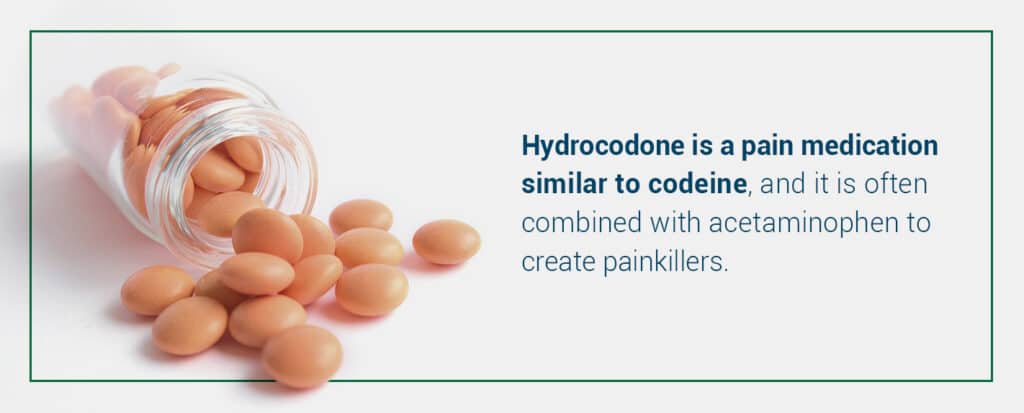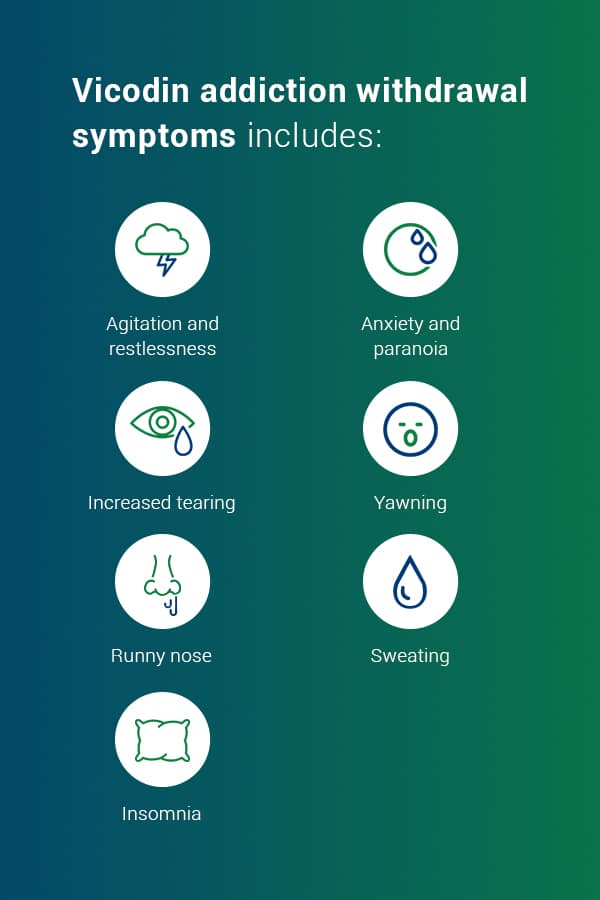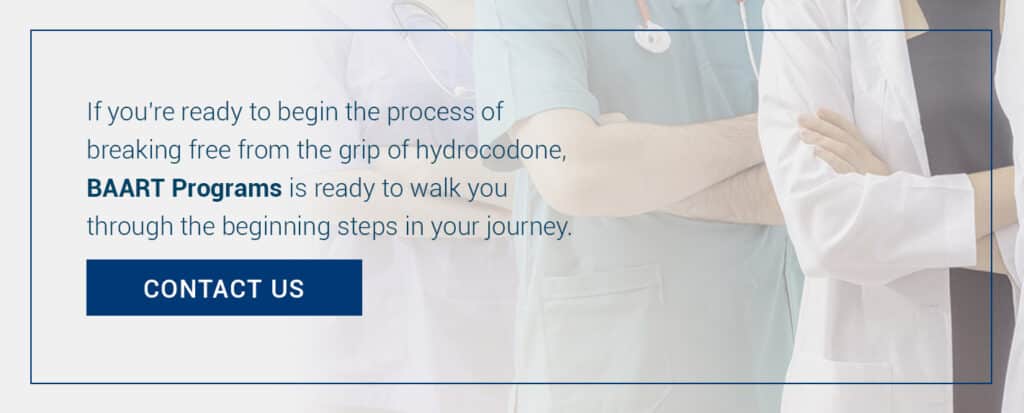Opioids are some of the most dangerous drugs in America. More than 130 people fatally overdose on opioids each day in the U.S., and many of them are among the 1.7 million people who struggle with prescription opioid use disorders.
Since the over-prescription of strong painkillers gained momentum in the 1990s, a small number of popular name brand drugs have emerged as central drivers of the opioid crisis. Among them is a household name you’ve almost certainly heard before: Vicodin®. This powerful drug is highly addictive, and many people don’t understand how it works before starting to take it.

Everything You Need to Know About Hydrocodone
Vicodin is a brand name for a medication formulation containing the drug hydrocodone. Hydrocodone is a pain medication similar to codeine, and it is often combined with acetaminophen to create painkillers. Vicodin is one of these hydrocodone and acetaminophen formulations. Other common name brands for drugs containing these two ingredients include:
- Lortab®
- Norco®
- Zohydro® ER
- Lorcet®
These drugs are all pain relievers prescribed to treat moderate to severe pain. The main differences between these medications are the exact proportions of hydrocodone to acetaminophen and the medium for delivery. For example, the only significant difference between Vicodin and Lortab is that Lortab comes as a liquid oral solution. Lorcet and Vicodin are extremely similar in both formulation and delivery method.
The difference between Vicodin and Norco is that Vicodin is only available as a single combination: 5mg hydrocodone and 500mg acetaminophen. Norco comes in three different strengths from 5mg to 10mg of hydrocodone all with 325mg of acetaminophen.
Zohydro ER is a relatively new drug designed to manage severe pain for which other treatment options are not effective.
How Hydrocodone Works
Hydrocodone, the main ingredient in Vicodin, is an opioid. Opioids are compounds naturally produced by the brain, which interact with opioid receptors throughout the brain, spinal cord, digestive tract and more sites within the body. These naturally occurring opioids are endogenous — meaning they are produced internally.
Compounds with similar structures also exist in nature. Drugs derived from the opium poppy, like morphine and heroin, can also bind to the brain’s opioid receptors. Man-made opioids like hydrocodone are synthesized to mimic the same structure and can bind to brain receptors as well. However, these external opioids exert a much stronger effect on the brain and body.
When hydrocodone binds to the corresponding receptors in the body, it alters the way neurons communicate with each other. The most useful effect of this alteration is blocking the perception of pain, which is why “prescription opioids” and “painkillers” are closely intertwined and sometimes used interchangeably. Along with pain relief, opioids bring on a feeling of euphoria that can lead people to abuse the drug. In addition to these two main benefits, Vicodin and other painkillers have some serious short-term side effects, including:
- Constipation
- Difficulty urinating
- Drowsiness
- Lightheadedness
- Impaired thinking
- Anxiety
- Unusual mood swings
- Dry throat
- Rash
- Itching
The chances of experiencing these side effects can be minimized by taking only the prescribed amount of medication. The unpleasant symptoms are sometimes enough to deter a person from beginning to abuse Vicodin, but others take more either in pursuit of the resulting euphoria, or because they feel the prescribed level of medication is not doing enough to alleviate their pain. Either way, ignoring the strict instructions on a prescription is a significant first step to addiction.

How Addiction Develops
When someone takes an opioid drug, the effects on the brain are profound. One of the key issues is the rush of dopamine experienced as a result of opioid use. Dopamine is a neurotransmitter that plays a central role in the way the brain processes reward and reinforcement. That “runner’s high” you get after an invigorating lap around the neighborhood is partially powered by a moderate release of dopamine, which is doing its job by rewarding you for a beneficial activity.
Opioids, on the other hand, trigger a flood of dopamine rather than a measured release. This is part of the euphoria effect. Over a period of sustained opioid use, the brain adjusts to the presence of opioids by reducing its dopamine production. When you remove opioids from the equation, the brain cannot readjust its production of dopamine and other necessary neurotransmitters quickly enough, leading to unpleasant symptoms of withdrawal.
When withdrawal begins, the psychological and physical effects are often strong enough to drive the individual right back to opioid use. Physical and mental dependence on a substance constitutes addiction.
Vicodin Addiction Signs and Symptoms
Identifying addiction to prescription painkillers like Vicodin is more complex than identifying it in purely illicit drugs. This difficulty is partially due to the phenomenon of tolerance. Tolerance develops as a person begins taking a drug consistently. The brain responds to this new condition by building up a resistance to the drug’s effects. Tolerance results in a person feeling less pain relief from taking a medication after an extended period.
Someone whose pain was well-controlled with a single Vicodin three months ago may need two at a time to avoid extreme pain today. Tolerance is a normal reaction to taking medication consistently, but it is also one component of addiction. When diagnosing an opioid use disorder (OUD), clinical professionals use these criteria from the Diagnostic and Statistical Manual of Mental Disorders, Fifth Edition (DSM-5).
- The person is taking more opioids than intended or for a longer time period than intended.
- There has been a consistent desire or unsuccessful attempts to reduce or stop opioid use.
- The person spends a great deal of time acquiring the opioid, using it and recovering from its effects.
- There is a frequent craving or strong desire to use the opioid.
- Use of the opioid is interfering with the fulfillment of major roles at work, home or school.
- The person continues to use opioids despite persistent or recurring social or interpersonal issues made worse by the opioid’s effects.
- The person has given up or reduced participation in social, occupational or recreational activities.
- The person continues to use opioids in situations where it is physically dangerous.
- The person continues to use opioids despite knowing they are causing physical or psychological problems.
- Tolerance, as defined by a need for increased amounts of opioids to achieve the desired effect or diminished effect with use of the same amount of the opioid.
- Withdrawal, as manifested by opioid withdrawal syndrome or taking an opioid to relieve or avoid symptoms of withdrawal.
Note that if a person is taking opioids as directed and prescribed by a physician, tolerance and withdrawal are not considered for the diagnosis. They are, however, considered if a person is taking prescribed medication in a way other than directed by the physician. The severity of an opioid use disorder depends on how many symptoms a person is experiencing. Someone with a mild OUD only displays two to three of the symptoms. The OUD is classed as moderate with four or five symptoms present. Six or more symptoms indicate a severe opioid use disorder.
Addiction to Vicodin must be taken seriously, no matter how minor the hydrocodone addiction symptoms may seem. Catching Vicodin addiction in its early stages can improve the chances of a full recovery, but even very severe addiction can be treated successfully with an evidence-based treatment program.

Treatment for a Vicodin Addiction
Getting effective help for hydrocodone addiction requires a program with two elements: a way to manage withdrawal symptoms during detoxification, and options for therapy that lay the foundation for sustained recovery.
One of the hardest steps for someone trying to quit is figuring out how to withdraw from Vicodin addiction. The symptoms are not life-threatening in most cases, but are certainly unpleasant enough to make someone return to opioid use immediately. The first stage of withdrawal symptoms includes:
- Agitation and restlessness
- Anxiety and paranoia
- Increased tearing
- Yawning
- Runny nose
- Sweating
- Insomnia
In the early stages, the worst withdrawal symptoms are psychological. In the most intense stages, individuals must contend with painful physical symptoms like these:
- Goose bumps
- Nausea
- Vomiting
- Abdominal cramping
One of the most effective ways to minimize the symptoms of withdrawal is to begin medication-assisted treatment (MAT). MAT involves taking a prescribed medication that stops the worst symptoms of Vicodin withdrawals from happening in the first place.
Types of Medication-Assisted Treatment
The two types of medication commonly used for MAT are methadone and buprenorphine.
- Methadone: Methadone has been in use as an opioid addiction treatment aid since the 1970s, and is widely considered the gold standard. It binds fully to opioid receptors, fulfilling the brain’s need for opioids. However, methadone does not elicit euphoria when taken as prescribed. Instead, it allows the person taking it to avoid withdrawal symptoms and feel stable enough to participate in a treatment program.
- Buprenorphine: Buprenorphine is a much newer medication. Approved by the FDA in 2012 and commonly known by the brand name Suboxone®, buprenorphine is only a partial opioid agonist. It only binds partially to opioid receptors and is much more difficult to abuse due to a “ceiling effect” that prevents abuse by limiting the pleasure one can experience by taking too much of the medication. Buprenorphine is highly effective as a part of MAT, although it is more expensive than methadone.
There are two routes to MAT with these medications: tapering and maintenance. Some treatment programs begin with the goal of using one of the medications to taper off opioids completely, which is also referred to as detoxification or detox. Participants in these programs only receive medication for a pre-determined amount of time that may be adjusted to meet the needs of the individual.
Maintenance programs assume that participants will take the medication for the long term. People taking the medication for months or years are maintaining their sobriety through use of the medication. Many clinics offer a flexible approach and will work with you to determine what the best course of treatment is based on your history and the severity of your Vicodin addiction.
FAQs About Vicodin (Hydrocodone) & Addiction
The topic of hydrocodone addiction is vast and complex. There are several frequently asked questions you’ll find the answers to below.
Q: How long does hydrocodone stay in your system?
A: There is no simple answer here. The factors that influence this are: age, body size, liver and kidney function, metabolism, frequency of use and duration of use.
Q: What’s the difference between hydrocodone and oxycodone?
A: The two drugs are chemically similar and both offer relief of pain. Hydrocodone has one fewer oxygen atom than oxycodone and acts as a cough suppressant as it is derived from codeine. Oxycodone is derived from a compound called thebaine and does not have the cough suppressant effect.
Q: Does hydrocodone have any adverse drug interactions?
A: Yes. Hydrocodone has hundreds of drug interactions, many of which are dangerous. Mixing hydrocodone with alcohol or other drugs like benzodiazepines or stimulants can lead to unpredictable effects and potential overdose.
Q: How long does it take to become addicted to hydrocodone?
A: Physical dependence can occur after about two weeks of daily opioid use. Psychological dependence can occur in this time frame or take several months to develop. It all depends on the individual.
Q: How long does treatment for hydrocodone addiction last?
A: This depends on whether you are attending residential rehab or an outpatient clinic. Residential treatment is usually offered in increments of 30 days up to 120 days. If you choose a MAT maintenance program, your treatment can go on as long as you feel comfortable on the medication.
How to Overcome a Vicodin Addiction
Addiction to Vicodin is a frightening state to struggle with, but help is available. The first step to recovery is choosing to seek help. If you are not comfortable talking to your doctor about addiction and options for treatment, you can go directly to the Substance Abuse and Mental Health Services Administration (SAMHSA) via their National Helpline. By calling 1-800-662-HELP (4357), you can receive referrals to crucial resources like support groups, community organizations and treatment facilities near you.
If you’re located in the San Francisco Bay Area, BAART Programs offers the leading evidence-based treatment for Vicodin addiction. Since 1977, BAART Programs has been building experience in the treatment of opioid use disorders of all varieties. Through a proven combination of counseling and medically supervised treatment using buprenorphine or methadone, BAART Programs can help give you the best chance of a new life free of Vicodin addiction.
One of our unique features is the integration of primary health care integration, allowing you to bring multiple aspects of your health into alignment. By treating your addiction within a community of medical professionals, you get the best care possible.
If you’re ready to begin the process of breaking free from the grip of hydrocodone, BAART Programs is ready to walk you through the beginning steps in your journey. We have multiple locations in the Bay, San Joaquin and Los Angeles areas for your convenience. Don’t hesitate to contact us through our online form, or call one of our locations directly. Our knowledgeable and compassionate representatives are here to answer your questions and make your first steps to recovery as smooth as possible




